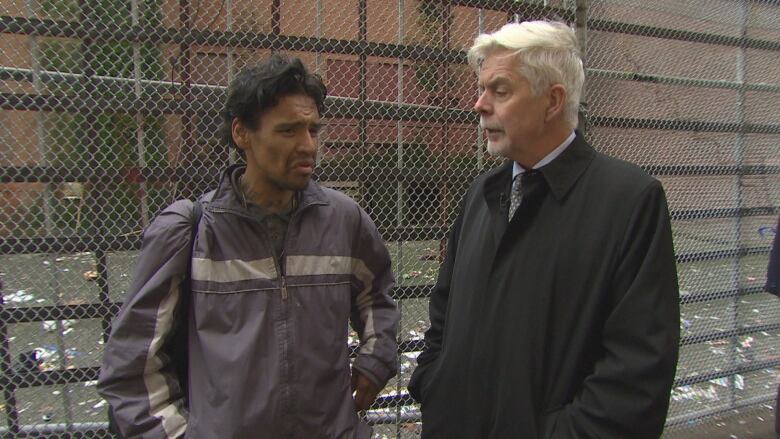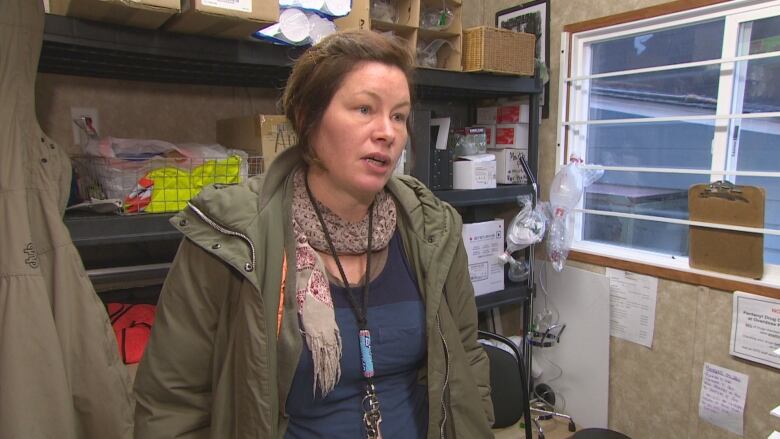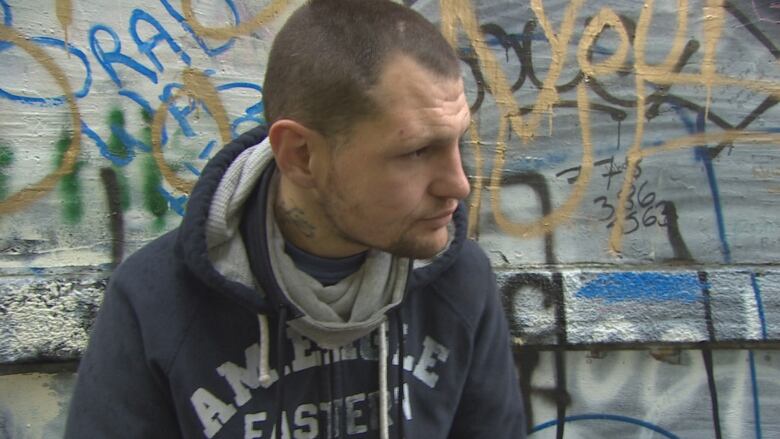Crystal methamphetamine: the 'elephant in the room' on Vancouver's Downtown Eastside
Before the current opioid crisis, doctors were struggling with skyrocketing crystal meth use and still are

Crouched on the wet floor of the Overdose Prevention Society's trailer on Vancouver's Downtown Eastside, Cody Waldner talks about the first time he got high on crystal methamphetamine.
"I moved to the city and everyone I knew did meth. So eventually I tried it," said Waldner.
He was 19 when he said he was offered a hit of the drug at his friend's house.
"I felt like Superman," said Waldner, now 30 and still a regular user. He routinely comes to the tents at the overdose prevention site on East Hastings Street to smoke the drug.
Waldner, originally from Alberta,has no fixed address on the Downtown Eastside. He wants to stop using the drug.
"I'm on the verge of losing my mind ... I don't have nowhere else to go," said Waldner.

Crystal methamphetamine known on the street as jib can be snorted, eaten, smoked or injected. The high can last as long as 12 hours.
It's addictive, cheap and easy to find on the Downtown Eastside. And its use is on the rise, B.C. health officials say.
Front-line doctors say they're struggling to treat patients addicted to crystal meth because of the effects of the drug, which include psychosis, paranoia, hallucinations and aggression.
Those symptoms coupled with the fact that there are no dedicated pharmacological treatments for meth addiction make it difficult for doctors to get through to their patients, let alone begin the process of trying to help them quit the highly addictive drug.
Health officials say they can only tend to the fallout:dealing with the streams of crystal meth users, often in states of prolonged psychosis, who flood clinics and hospital emergency rooms.
Since 2005, there has been a 600 per cent increase in the use of the drug at Vancouver's supervised injection facility.
According to numbers from Vancouver Coastal Health, 4,981 people injected the drug at the Insite facility in 2005. By 2016, that number soared to 35,238.
'It's an emergency too'
Long before the potent opioid fentanyl made headlines for contaminating street drug supplies and killing thousands of people in B.C. Dr. Susan Burgess was treating patients grappling with their addiction to methamphetamine.
She said the problem is getting worse.
"We're still at a loss with how to deal with [methampthetamine] in our clinics," said Burgess, a physician withthe Vancouver Native Health Society on the Downtown Eastside.
"Every day, we have to certify someone who is just totally violent, out of control and very, very impaired from this drug," said Burgess.

There is no dedicated treatment formethamphetamine addiction. Unlike heroin or other opioids, there aren't effective forms of substitution therapy, such as methadone or suboxone, to treat it.
"[Methamphetamine] was for us the clinical crisis that was most difficult to deal with,"Burgess said.
"We used to say: give me a heroin addict anytime. That's easy, we've got something to do. But we've got nothing for cocaine or crystal meth in the same category other than treating the psychosis."
The harsh effects of crystal meth especially the psychosis make it hard for some doctors to have even basic interactions with patients, let alone treat any other illnesses they have.
"[Methamphatemine] is the elephant in the room."
"It's true.It's the drug that is making it most difficult for health care providers to provide health care.... It's an emergency, too," said Burgess.
Street treatment
On a windy Wednesday afternoon, Dr. Bill MacEwan spots a familiar face in the alley near Insite on East Hastings Street: 34-year-old James Sanderson, a crystal meth user.
"I started smashing up [crystal methamphetamine] on Dec. 24, 2014," Sanderson tells MacEwan.

"I kept going until Dec. 31, and then carried on from that day. It's been a nuisance since and is causing me hell."
MacEwanisa psychiatrist with St. Paul's Hospital but works mostly out of a clinic in Vancouver. Much of his outreach happens in alleys like this.
"The popularity [of methamphetamine] is huge," said MacEwan.
One of the reasons crystal meth is so popular, he said, is its relatively low cost.
A 0.1 g bag also known as a point can be bought for as cheap as $10 on the Downtown Eastside. That's roughly half the price of the same amount of heroin.

"[Methamphetamine] is one of those medications that can help you feel absolutely wonderful. I've had patients tell me ... they feel like God."
MacEwan said if a patient voluntarily wants to get off the drug, the best time to try is once they're sober and in a health facility.
"You virtually have to get [the methamphetamine] out of your system," said MacEwan.
From there, MacEwan said group or support programs play a key role in helping people stay clean.
The problem is actually getting a patient to that stage and keeping them there.

More resources
Roughly 700 people visit the Overdose Prevention Society's site on the Downtown Eastside perday, according to the society's founder Sarah Blyth.
She said around half of the visitors are smokers, and most of themusing crystal meth or cocaine.
Blythhas also seen an increased prevalence of meth.
"There's not a lot of resources for people addicted to crystal meth, especially smokers," said Blyth.
Health care providers are exploring alternative forms of treatment, but Burgess andMacEwanboth said any psychiatric engagementmust be coupled with some kind of community support program ideally one that is regular and gives them a sense of value.
That's exactly what Waldner, who has now been addicted to the drug for 11 years, wants too.

"We need more programs that are integrating us.... More daily programs that can be made available,"Waldner said.
"I do think people should talk about it more. I feel as if us and our problems are just swept under the rug."
Corrections
- A previous headline on this story incorrectly said there has been a 600 per cent increase in the use of crystal meth in Vancouver. In fact, the increase in that drug use was at Insite.Nov 23, 2017 12:10 PM PT













_(720p).jpg)


 OFFICIAL HD MUSIC VIDEO.jpg)
.jpg)



























































































